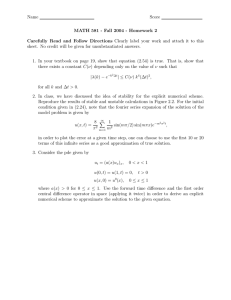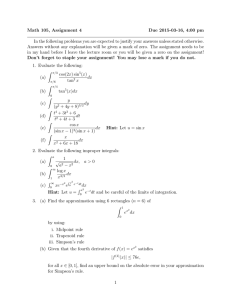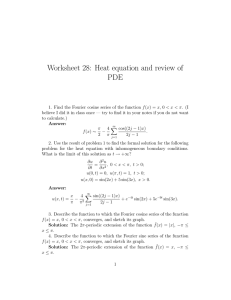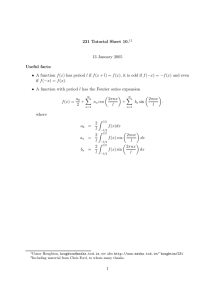Problem Set 6
advertisement
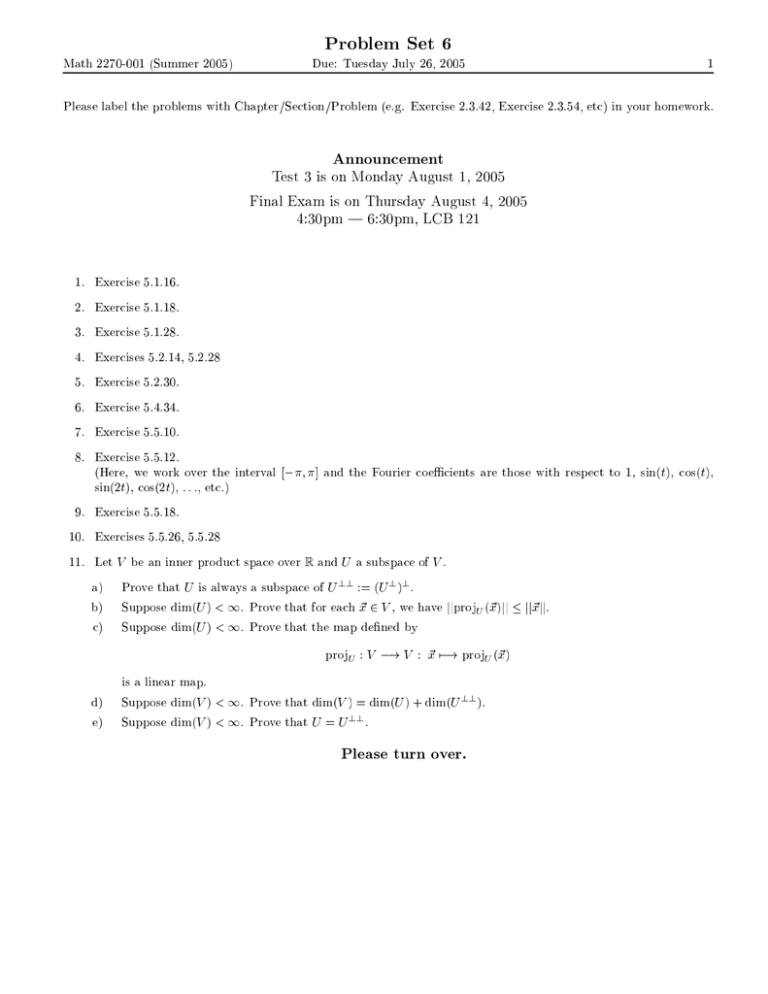
Math 2270-001 (Summer 2005) Problem Set 6 Due: Tuesday July 26, 2005 1 Please label the problems with Chapter/Section/Problem (e.g. Exercise 2.3.42, Exercise 2.3.54, etc) in your homework. Announcement Test 3 is on Monday August 1, 2005 Final Exam is on Thursday August 4, 2005 4:30pm | 6:30pm, LCB 121 1. 2. 3. 4. 5. 6. 7. 8. Exercise 5.1.16. Exercise 5.1.18. Exercise 5.1.28. Exercises 5.2.14, 5.2.28 Exercise 5.2.30. Exercise 5.4.34. Exercise 5.5.10. Exercise 5.5.12. (Here, we work over the interval [ ; ] and the Fourier coecients are those with respect to 1, sin(t), cos(t), sin(2t), cos(2t), : : :, etc.) 9. Exercise 5.5.18. 10. Exercises 5.5.26, 5.5.28 11. Let V be an inner product space over R and U a subspace of V . a) Prove that U is always a subspace of U ?? := (U ? )? . b) Suppose dim(U ) < 1. Prove that for each ~x 2 V , we have jjprojU (~x)jj jj~xjj. c) Suppose dim(U ) < 1. Prove that the map dened by projU : V ! V : ~x 7 ! projU (~x) d) e) is a linear map. Suppose dim(V ) < 1. Prove that dim(V ) = dim(U ) + dim(U ?? ). Suppose dim(V ) < 1. Prove that U = U ?? . Please turn over. Math 2270-001 (Summer 2005) Problem Set 6 Due: Tuesday July 26, 2005 12. Maple Problem Dene f (t) as follows: f (t) := t 1; t + 1; 2 t0 0t a) Download the two \Fourier approximation" les from the course web page. The second one is an executable XMaple worksheet while the rst one is the same worksheet in pdf format. b) Use Xmaple, mimicking the downloaded worksheet, compute the Fourier approximations of f (t) over the interval [ ; ] with respect to the L2 inner product and each of the following spanning sets: i) [ sin(t); sin(2t) ] ii) [ sin(t); sin(2t); : : : ; sin(7t) ] iii) [ sin(t); sin(2t); : : : ; sin(20t) ] iv) [ t; t3 ; t5 ; t7 ] v) [ t; t3 ; t5 ; t7 ; : : : ; t39 ] Compute the error for each Fourier approximation. Plot each approximation and f (t) on the same graph. c) Submit your worksheet as usual with the rest of your problem set. Remarks When dening the function f (t) above in Maple, you may nd the built-in Maple function Heaviside useful. Look it up. A function g(t) is said to be \odd" if g(t) satises g( t) = g(t) for all t, and g(t) is said to be \even" if g( t) = g(t) for all t. Note f (t) is an odd function as well as sin(mt) and all odd powers of t, whereas cos(mt) and all even powers of t are even functions. Convince yourself that any Fourier approximation of an odd function does not contain the even terms cos(mt) or t2m . Note that approximation gets better when more terms are included. Note how the \sine" approximations are \stuck" at zero at the end points of the interval [ ; ], while the \polynomial" approximations do not have this shortcoming. Think about why this is so. We are using dierentiable functions (trigonometric functions and polynomials; they are dierentiable innitely many times) to approximate the function f (t), which is not even continuous. We expect the approximation to be particularly inaccurate near points of discontinuity. Notice how each Fourier approximation \overshoots" at the point of discontinuity of f (t). This phenomenon is called the Gibbs phenomenon.
